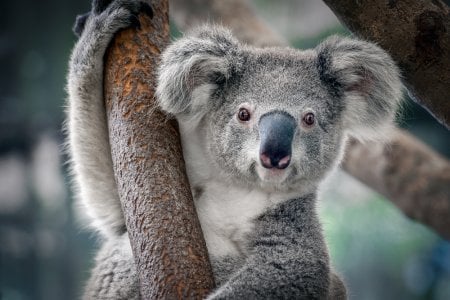Ecologist raises alarm bells for 40,000 Koalas facing dire fate
By
VanessaC
- Replies 3
Long admired for their cuddly appeal, a quintessential Australian icon—the koala bear—has been a major draw for tourists, generating millions of dollars for Australia's tourism industry.
However, a grave crisis has unveiled in a remote part of the country, where thousands of koalas face a potential catastrophe, including starvation and death.
In Southwest Victoria, a vibrant population of koalas thrives in a timber plantation hub known as the Green Triangle, according to Ecologist Dr Stephen Phillips.
These plantations were not initially intended as koala habitats.
However, they became a haven for these endearing marsupials because of the high nutrition of blue gum trees, the primary plantation in this region.
These koalas are now in grave danger as their homes are being cut down and turned into woodchips for export.
The dilemma lies with the Victorian Department of Energy, Environment and Climate Action’s (DEECA) alleged refusal to evacuate the koalas prior to the harvesting of plantations, a stance driven by animal welfare concerns.
Dr Phillips, however, argued that leaving the animals in the plantations may lead to unnecessary displacement and injuries.
'I’ve been in those plantations in the southwest where I’m aware there are high densities of koalas…and the injuries suffered by these animals are horrendous,’ he said.
‘And yet, our governments just turn a blind eye and hope it's all going to bl***y well go away. But the reality is it’s not going to go away.'
The bleak scenario doesn't end there. Following the harvesting of trees, there are often surges in koala road fatality numbers as they search for new habitats.
Unfortunately, the new habitats they find often already harbour overpopulated koala communities, which can lead to starvation and might eventually require euthanasia.
Dr Phillips argued that ecologists are now able to translocate koalas to new habitats with 100 per cent success and no moralities.
Furthermore, areas like the Grampians, where fire has wiped out koala populations, could benefit from the process.
Official estimates by the Victorian government indicate there are nearly half a million koalas (459,865) in the state, with a majority being in the Southwest, including 210,277 in native forests and 42,581 in plantations.
This figure has prevented koalas from receiving the 'endangered' status in Victoria, unlike in the regions of NSW, Queensland, and ACT.
This has consequently deprived Victorian koalas of the crucial federal protection under the Environment Protection and Biodiversity Conservation Act (EPBC).
However, Dr Phillips believes that these estimates were grossly inflated.
He pointed out that the distribution of koalas across the state is highly inconsistent as some areas demonstrated dense populations, while others were sparsely distributed in other patches of forest.
He contends that the actual figure might be as low as a quarter of the government's estimate.
'The number of koalas is often used to increase the scale of the problem. People will say, that’s a lot of bl***y koalas. And certainly it is. But so is a ten-fold reduction in this number. It doesn’t really matter. It’s about a humane, coordinated and well-informed approach,' he reiterated.
In response to this critical situation, DEECA maintained that it's steadfast in ensuring the 'long-term protection and survival of Victoria’s koalas' and that the state government’s management strategy allows it to 'better support' the plantation industry in protecting animal welfare and habitat.
'The Victorian government has invested over $3 million over two years to support the delivery of the strategy, including on-ground koala management programs, a statewide survey to paint a clearer and more accurate picture of koala abundance, and research helping to conserve Victoria's koala populations well into the future.'
Over time, the issue with koalas is expected to decrease as pine trees, which cannot be used as feed trees, gradually replace blue gums.
However, Dr Phillips is calling on the government to move quickly and come up with a fresh strategy to assist koalas residing on active plantations.
'The authorities think, “Well, this will go on for several more years,” and yes, we'll have periodic outbursts from the community and other people, and eventually the problem will go away.'
'It's a terrible attitude for Victoria. Many see koalas as a pest rather than a national identity.'
 What are your thoughts on this latest issue, dear members? Let us know in the comments below!
What are your thoughts on this latest issue, dear members? Let us know in the comments below!
However, a grave crisis has unveiled in a remote part of the country, where thousands of koalas face a potential catastrophe, including starvation and death.
In Southwest Victoria, a vibrant population of koalas thrives in a timber plantation hub known as the Green Triangle, according to Ecologist Dr Stephen Phillips.
These plantations were not initially intended as koala habitats.
However, they became a haven for these endearing marsupials because of the high nutrition of blue gum trees, the primary plantation in this region.
These koalas are now in grave danger as their homes are being cut down and turned into woodchips for export.
The dilemma lies with the Victorian Department of Energy, Environment and Climate Action’s (DEECA) alleged refusal to evacuate the koalas prior to the harvesting of plantations, a stance driven by animal welfare concerns.
Dr Phillips, however, argued that leaving the animals in the plantations may lead to unnecessary displacement and injuries.
'I’ve been in those plantations in the southwest where I’m aware there are high densities of koalas…and the injuries suffered by these animals are horrendous,’ he said.
‘And yet, our governments just turn a blind eye and hope it's all going to bl***y well go away. But the reality is it’s not going to go away.'
The bleak scenario doesn't end there. Following the harvesting of trees, there are often surges in koala road fatality numbers as they search for new habitats.
Unfortunately, the new habitats they find often already harbour overpopulated koala communities, which can lead to starvation and might eventually require euthanasia.
Dr Phillips argued that ecologists are now able to translocate koalas to new habitats with 100 per cent success and no moralities.
Furthermore, areas like the Grampians, where fire has wiped out koala populations, could benefit from the process.
Official estimates by the Victorian government indicate there are nearly half a million koalas (459,865) in the state, with a majority being in the Southwest, including 210,277 in native forests and 42,581 in plantations.
This figure has prevented koalas from receiving the 'endangered' status in Victoria, unlike in the regions of NSW, Queensland, and ACT.
This has consequently deprived Victorian koalas of the crucial federal protection under the Environment Protection and Biodiversity Conservation Act (EPBC).
However, Dr Phillips believes that these estimates were grossly inflated.
He pointed out that the distribution of koalas across the state is highly inconsistent as some areas demonstrated dense populations, while others were sparsely distributed in other patches of forest.
He contends that the actual figure might be as low as a quarter of the government's estimate.
'The number of koalas is often used to increase the scale of the problem. People will say, that’s a lot of bl***y koalas. And certainly it is. But so is a ten-fold reduction in this number. It doesn’t really matter. It’s about a humane, coordinated and well-informed approach,' he reiterated.
In response to this critical situation, DEECA maintained that it's steadfast in ensuring the 'long-term protection and survival of Victoria’s koalas' and that the state government’s management strategy allows it to 'better support' the plantation industry in protecting animal welfare and habitat.
'The Victorian government has invested over $3 million over two years to support the delivery of the strategy, including on-ground koala management programs, a statewide survey to paint a clearer and more accurate picture of koala abundance, and research helping to conserve Victoria's koala populations well into the future.'
Over time, the issue with koalas is expected to decrease as pine trees, which cannot be used as feed trees, gradually replace blue gums.
However, Dr Phillips is calling on the government to move quickly and come up with a fresh strategy to assist koalas residing on active plantations.
'The authorities think, “Well, this will go on for several more years,” and yes, we'll have periodic outbursts from the community and other people, and eventually the problem will go away.'
'It's a terrible attitude for Victoria. Many see koalas as a pest rather than a national identity.'
Key Takeaways
- Dr Stephen Phillips, an Ecologist, has issued a warning of the dire situation thousands of wild koalas in Victoria's Southwest are facing as habitat destruction for woodchip export threatens their survival.
- Despite the koala populations thriving in timber plantations due to high-nutrient blue gum species, habitat destruction often leads to avoidable injuries, displacement, and death among the koalas.
- Authorities have been reluctant to support koala translocation prior to harvesting plantations, but Phillips argued that ecologists can now do so with high success and no mortalities.
- The Victorian government continues to work on koala protection and management, but Phillips and conservationists urged immediate action to devise a plan for the well-being of koalas in existing plantations.








